Shinkansen 新幹線
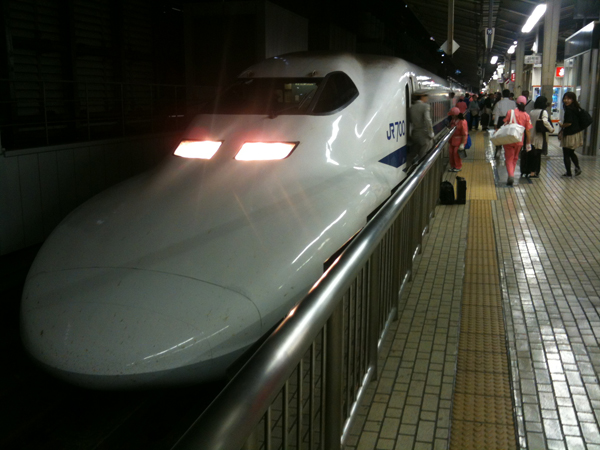 My first thought was: "it looks just like a crocodile." But even though it glided into the station as smoothly and effortlessly as a croc in the river, that's where the similarity ended. Even slowing down, the speed it hit the station left one in no doubt that this thing wanted to run. It is still going fast because 12 of its 16 cars needed to pass us before it stopped, and there was no time to waste. (Try the video below.)
My first thought was: "it looks just like a crocodile." But even though it glided into the station as smoothly and effortlessly as a croc in the river, that's where the similarity ended. Even slowing down, the speed it hit the station left one in no doubt that this thing wanted to run. It is still going fast because 12 of its 16 cars needed to pass us before it stopped, and there was no time to waste. (Try the video below.)
Every visitor to Japan wants to ride the bullet train, and we were no exception. It's actually a remarkable piece of marketing, because although it was a technological marvel when it debued in 1964, that was 50 years ago now, and today any number of other services, including Eurostar and France's TGV attain similar (170 mph) operating speeds.
It's really pretty embarrassing to note that the Boston - Washington Acela service is the only American train service exceeding the US Department of Transportation's 125 mph definition of high speed train (already exceeded by the Shinkansen in 1964) and today it still only has a maximum operating speed of 150 mph. Of course the thing that really kills it is that it only reaches these speeds over 28 miles of track in Rhode Island (just over 11 minutes) with an overall average speed of 67 mph. The Shinkansen services by contrast are only not travelling at their maximum operating speed when they are stopping and starting at stations. Most laughable of all (c'mon people, are we serious?) is that some parts of the Acela's catenary system were contructed "prior to 1935" You can't make this stuff up.
Japan Rail Pass
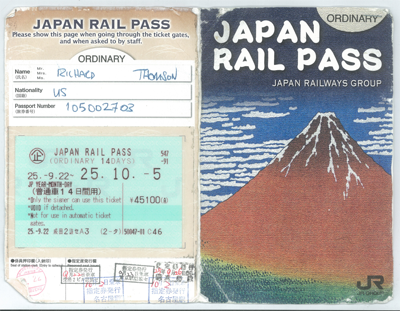 A handmade sign on the wall in the Japan Rail Pass Office said (in English): "Lost, stolen or washed passes cannot be replaced."
A handmade sign on the wall in the Japan Rail Pass Office said (in English): "Lost, stolen or washed passes cannot be replaced."
We bought 14 day rail passes, which were not exactly cheap, but what I really like about any sort of season pass is that in stark contrast to pay-as-you-go, every time you use it, it gets cheaper. It was a win when we found it worked on local trains, or even on some of the Tokyo subway lines. An even bigger benefit it turned out, was that instead of validating your ticket as you went through a turnstile (and therefore commiting yourself to be one side of the barrier or the other) we could wave the pass at the guard and pass back and forth through the barrier as we pleased. Considering how many mistakes we made, this was a huge win.
Having committed to the passes, we were then free to travel as far as we wanted, and whenever we wanted. So when we found ourselves with an extra half a day we could jump on the train Nagoya - Kobe, 120 miles, 70 mins for "free." The passes did not cover the fastest trains but I regarded that as a feature: the "slow" trains traveled at the same speed as the fast trains, they just stop more often. We typically only lost 10-20 minutes, and had all the fun of stopping and starting.
Apropo of not much, but this is the only place to put it, I want to sing the praises of http://www.hyperdia.com/ which is one of the best travel sites I have ever used. Type in a starting point and an ending point, this site comes back with choices of times, choices of routes, differences in travel time, where and when you have to change trains, and what each option costs for comparison. And months later when I had an opportunity to cross check what it had suggested with my actual experience on the ground, it was accurate to the minute, and i dare say to the yen too, if all our tickets were not free.
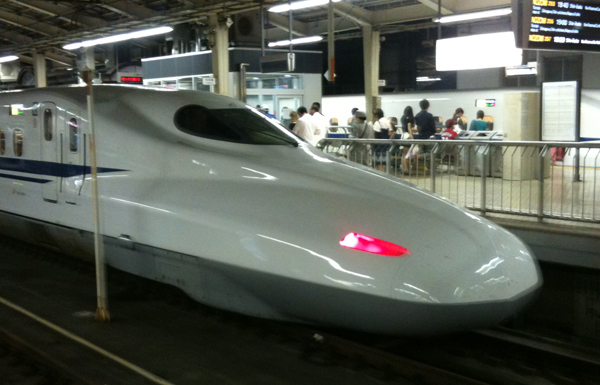 Shin-kan-sen: New Trunk Line. Between Tokyo and Osaka up to thirteen trains per hour with sixteen cars each (1,323 seats capacity) run in each direction with a minimum headway of three minutes between trains and a normal operating speed of around 280km/hr (170mph). The Shinkansen is very reliable thanks to several factors, including its near-total separation from conventional rail lines. Consequently, the Shinkansen is not affected by slower local or freight trains and has the capacity to operate many high-speed trains punctually. It seems like they got the right-of-way for the Shinkansen by simply building it over the top of everything else. That is certainly true of the stations, where for example the Shinkansen train station Shin-Osaka (New-Osaka) is build directly over the top of Osaka, the old "regular" train station.
Shin-kan-sen: New Trunk Line. Between Tokyo and Osaka up to thirteen trains per hour with sixteen cars each (1,323 seats capacity) run in each direction with a minimum headway of three minutes between trains and a normal operating speed of around 280km/hr (170mph). The Shinkansen is very reliable thanks to several factors, including its near-total separation from conventional rail lines. Consequently, the Shinkansen is not affected by slower local or freight trains and has the capacity to operate many high-speed trains punctually. It seems like they got the right-of-way for the Shinkansen by simply building it over the top of everything else. That is certainly true of the stations, where for example the Shinkansen train station Shin-Osaka (New-Osaka) is build directly over the top of Osaka, the old "regular" train station.
The Shinkansen uses 1,435 mm (the international standard, aka 4ft 8½in, aka the width of a Roman chariot axle) in contrast to the 1,067 mm narrow gauge of older lines. In 2012, JR Central reported that the Shinkansen's average delay from schedule per train was 36 seconds. This includes delays due to uncontrollable causes, such as natural disasters. Lines are served by multiple train categories, ranging from the fastest category that stops only at major stations to the slowest category that stops at every station along the way. If a train is more than 10 minutes late, the conductor hands out late passes for your boss.
A day in the life of a Shinkansen voyager
Up on the top floor of the station, where they keep the Shinkansen tracks, one is assaulted by the constant bing-bongs, chimes, announcements, incoming trains, outgoing trains who-knows-what other important stuff being relayed. Like living inside a video game.
Wave your mouse over the picture (or black box), and a start button should appear. Press it. The first pieces of video I ever shot. Gives a good impression of the speed and length of the train and some of the noise and constant announcements. |
Through the windows we watched the crew spin the seats around so they were all facing forward again, replace the headrest cloths and wipe down all the surfaces. In 4 minutes and 58 seconds the doors opened again, the pink army disembarked and we all piled on. |
We watched a (fastest) train depart. The station/platform supervisor looked at his watch, blew his whistle, and gave a very snappy, official-looking "wagons ho!" gesture with his gloved hand and the train started to roll simultaneously. The conductor was leaning out of the window, facing backwards, as the train departed, holding a salute to everyone on the platform watching.
 |
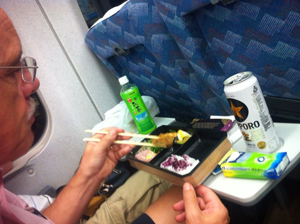 |
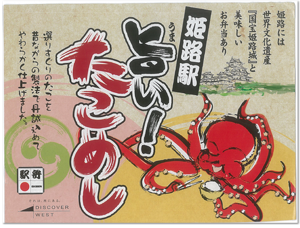 |
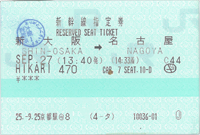
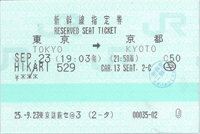 Finally it was our turn. The Shinkansen set out to mimic the air travel experience, and it's actually a little disappointing how well they have succeeded. From the square little windows to the spartan interior it is very much like air travel. But romance and marketing count for a lot. I still love the adventure of air travel despite the accommodation shortcomings, and I still loved every minute of the Shinkansen experience.
Finally it was our turn. The Shinkansen set out to mimic the air travel experience, and it's actually a little disappointing how well they have succeeded. From the square little windows to the spartan interior it is very much like air travel. But romance and marketing count for a lot. I still love the adventure of air travel despite the accommodation shortcomings, and I still loved every minute of the Shinkansen experience.
A very proper English lady announced our progress. "This train will safely make a brief stop at Yokohama ..." Or wherever. Since we were not on a fast train, she did this every half hour or so. No problem. Guards and other train personnel turned to bow when entering or leaving the car.
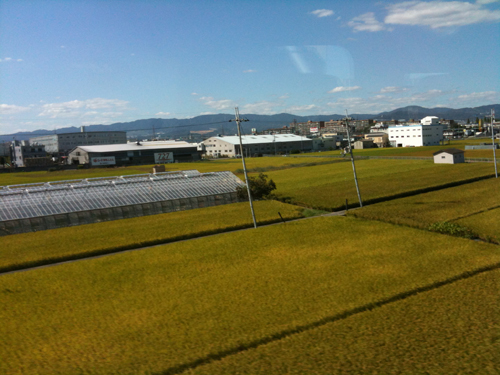 One of those other personnel was a lady with a little trolley service, but I never saw anyone buy anything from it (though we were travelling off-peak, and in half-empty cars). But instead, many people had brought their beloved bento boxes, and some of us had brought beer too. Bento boxes were great. A meal in a box for $4 to $8 typically. And the now familiar and oh so delicious combination of pickles, rice, some feature (sushi, octopus, breaded pork, or any one of twenty other things), and more pickles.
One of those other personnel was a lady with a little trolley service, but I never saw anyone buy anything from it (though we were travelling off-peak, and in half-empty cars). But instead, many people had brought their beloved bento boxes, and some of us had brought beer too. Bento boxes were great. A meal in a box for $4 to $8 typically. And the now familiar and oh so delicious combination of pickles, rice, some feature (sushi, octopus, breaded pork, or any one of twenty other things), and more pickles.
In no time, we were tearing across the landscape at 170mph. The sudden whoosh and lurch sideways as two passing trains were sucked towards each other never ceased to make me jump out of my skin, and to consider the 350 mph closing speed. Apparently the cars are pressurized to prevent your ears popping as the train entered tunnels.
Adam went to the bathroom, and to his surprise it was not working properly. As he opened the door again, there was man with a clipboard waiting outside to fix it.
But out in the countryside I was struck by how often we seemed to be at roof-top height, making the shiny roof tiles of the older homes very obvious. The view was all tiles, telegraph poles, and TV antennae. Interspersed occasionally by rice paddies, baseball diamonds, driving ranges and more rice paddies. Thus confirming my speculation that the tracks had been built straight over the top of the old system, presumably still plying away underneath.
Standing by the door waiting to exit, we came across another English language sign. "If you open this cover, you will be inquired by crew." Who will presumably be standing right behind you with a clipboard before you have time to turn around to check who is watching.
SMAGLEV and Railway Park: The JR Museum ![]()
We saw a poster at the Nagoya JR Station advertizing "The SMAGLEV and Railway Park" which, looking at the writing, seemed to imply to Adam that it was an exhibition on magnetically levitated rail service, but looking at the pictures implied to me "Shinkansen Museum." It was in a place neither of us had heard of, but sounded like a place both of us could be amused by. Perhaps more importantly, it was a destination neither of us could imagine getting on the agenda of any future visits with any future companions, so it was now or never. Alistair confirmed that its exotic location was in fact an outer suburb of Nagoya accessible at the end of a local rail line. So "now" was at least a practical possibility. Done. We would squeeze it in before our return to Tokyo that evening.
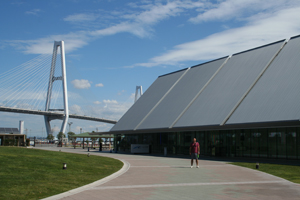 |
Old hands now, we followed signs to the Aonami Line and bought two tickets to the end of the line and back. It was a non-descript journey through non-descript suburbs, but there was no mistaking the huge exhibition hall that we passed immediately before the last station. That's Adam standing around half way along the thin end, where the entrance must be hiding somewhere. On the right here is Dr Yellow (that's the Japanese term). Dr (tester and diagnoser) Yellow (paint) is famous and revered because of his prowess patrolling the lines at night, surveying and monitoring, sorry, diagnosing, the track and overhead wires. It does this at full speed. He was extremely popular with younger members of the crowd, who clearly recognised him, making me ponder how many of their British cousins would be familiar with his counterpart (sigh) The Flying Banana. |
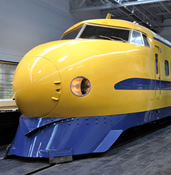 |
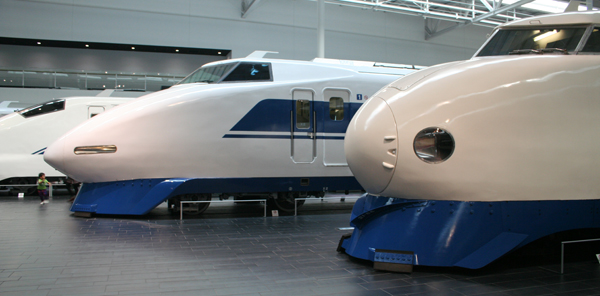 I rented an iPad with an English guide on it. It was awesome. In addition to a general description of every room, it displayed a map (just like the guide page below) and by touching any of the objects displayed on the floor plan it gave a detailed audio description of the item.
I rented an iPad with an English guide on it. It was awesome. In addition to a general description of every room, it displayed a map (just like the guide page below) and by touching any of the objects displayed on the floor plan it gave a detailed audio description of the item.
The aformentioned similarity to air travel is very striking in these shots, even mimicing the different eras of aeroplane noses (well I think so anyway). Many of the trains allowed you to walk through them, but again, airplane like, there was really not a lot to see. There are seats. They repeat.
More interesting was an interactive display showing how they can simultaneously pull up old rail and lay down new rail, so that the maintenance vehicle slowly (one assumes this task at least is not performed at operational speeds) moves along replacing the track underneath it.
There was also a huge model railway layout which ran to some sort of timetable so that over about 15 minutes it went from day to night time and back again. Thousands of little plastic people attended soccer matches, walked dogs, lay around on beaches, and permanently waited for trains on platforms. One was encouraged to find several that were performing more surprising/amusing/shocking activities.
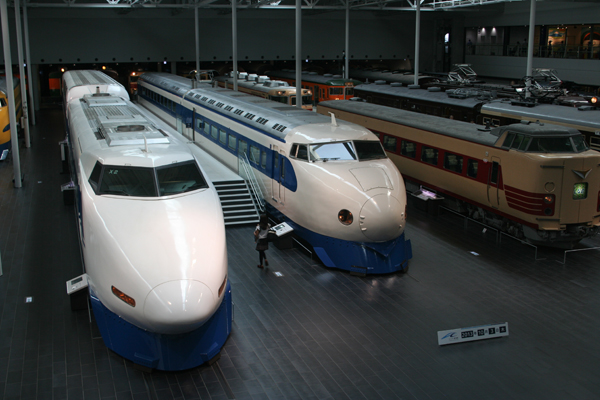
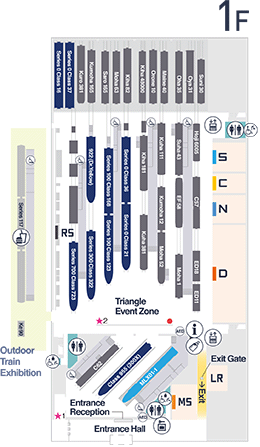
The advertized magnetic levitation exhibit was frankly disappointing, partly because it was small but also because they seemed so unoptimistic about its operational schedule. The plans for expanding the Shinkansen network were drawn out until at least 2045, and it was only towards the end of this time that there seemed any hope of a reasonable amount of the network converting to the mag lev system. And 30 years is many lifetimes in politics.
Lastly there were simulators, both of regular trains and of the Shinkansen. The Shinkansen was a full mockup of the cockpit, and only one person could play at a time. It was so popular that your ticket was put into a lottery for a drawing every 20 minutes. One glance at the screen made it clear that I would more happily enter my ticket into the lottery to not have to drive.
When we'd seen everything we wanted to see, played with everything we wanted to play with, we checked out the cafeteria (a bust) and the gift shop, where we both bought (non-motorised) "N" guage Shinkansen motor units (the front/back of the train) and made a note to buy a piece of track for it to sit on before we left Tokyo. That's what is in the picture that forms the header for this page. All done, it was time for Tokyo.
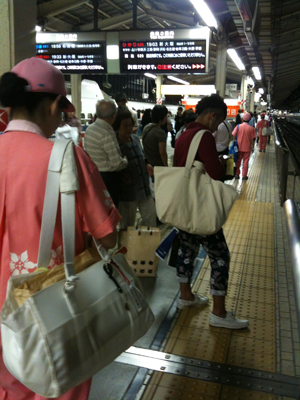 As we waited for the train in Tokyo (a terminus) I noticed a conspicuous number of women in pink uniforms gathering. By the time the train pulled in, there were one or two at the head of every line waiting at every door. Passengers disembarked, the pink uniforms boarded, and the doors shut again.
As we waited for the train in Tokyo (a terminus) I noticed a conspicuous number of women in pink uniforms gathering. By the time the train pulled in, there were one or two at the head of every line waiting at every door. Passengers disembarked, the pink uniforms boarded, and the doors shut again.